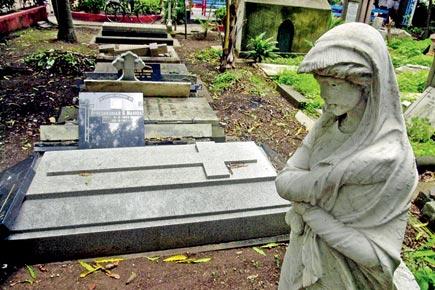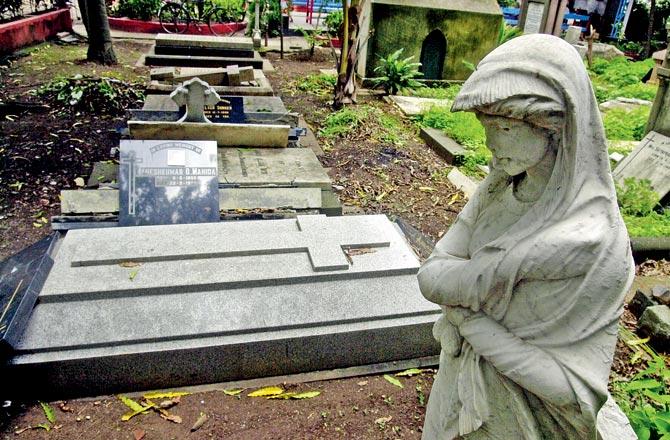Sewri Cemetery might be a forgotten footnote today; but inside lies a delightful chronicle that charts the making of a city


The grave of Frederick William Stevens at Sewri cemetery. File pic
ADVERTISEMENT
 After ages, this landmark on the eastern fringes of the original cluster of islands was in the news. And for the right reasons. Last Thursday, Mumbai's Sewri Cemetery was the first stop for Diana Roberston, the great-great-granddaughter of Frederick William Stevens while on a day-long visit to the city that her illustrious forefather and his son, Charles, helped shape over a century ago.
After ages, this landmark on the eastern fringes of the original cluster of islands was in the news. And for the right reasons. Last Thursday, Mumbai's Sewri Cemetery was the first stop for Diana Roberston, the great-great-granddaughter of Frederick William Stevens while on a day-long visit to the city that her illustrious forefather and his son, Charles, helped shape over a century ago.
It brought back memories of yours truly's many wanderings inside this historic albeit decadent treasure, where some of the city's founding fathers and famous names were laid to rest. At first glance, it doesn't exactly inspire the curious, or the history buff, even. But a closer look at the epitaphs and tombstones, some chipped, others vandalised, and you're bound to be hooked. Like we were; all in broad daylight, of course!
Until 1760, the English buried their dead at Mendham's Point Cemetery (near present day Lion Gate). It was shifted to Sonapur (Marine Lines) but had to be shifted once more to 'far-off' Sewree due to the increasing threat of epidemics. Arthur Crawford, the Municipal Commissioner of the time approved a plot beside the salt pans owned by the East India Company. In 1867, the cemetery was consecrated. Soon, the massive grounds became the final resting place for architects, officers of the BB &CI (Bombay Baroda & Central India), now Western Railway and GIP (Great Indian Peninsular), now Central Railway, chief justices, sheriffs, police chiefs, nurses, sailors from passing ships, chief surgeons, lieutenants, colonels, and Royal naval officers who are buried in either the Protestant or the Catholic sections.
Apart from FW Stevens' nondescript grave (a far cry from the architect responsible for creating a unique Bombay Gothic style), look out for James Taylor's grave. We dug deeper (pun intended) in the city's libraries to discover that this Secretary of the Bombay Chamber of Commerce as well as the Royal Asiatic Society, a Scotsman, had proposed to English author Charlotte Brontë when he came to India to set up an Indian branch of a publishing firm. She turned him down. Charlotte didn't want to settle in India and though they maintained a long distance correspondence for years, it didn't work out eventually. Who knows if Jane Eyre would have had a Bombay twist had Brontë accepted Taylor's proposal!
Another stunning section within is the Italian War Memorial erected by its government in 1954 as a salute to the Italian Prisoners of War who died in India from 1941-46. Every year, on November 2, the Italian Consulate conducts a solemn service to remember these soldiers.
As one negotiates the undergrowth, shrubbery and a sea of stone, granite and marble, many such fascinating, sometimes heart-tugging stories come to light. Like the mention we found of a British inventor: "He lost his life from the bursting of his balloon." Along the way, we spotted the graves of two icons of the arts – Dom Moraes' and FN Souza. Both were fairly sombre reminders; like anti-climaxes of their dramatic, vibrant lives.
Enriched and engaged, we gave a final gratifying look at the rows of stories that lay behind us, because somewhere within it lay the story of Bombay.
mid-day's Features Editor Fiona Fernandez relishes the city's sights, sounds, smells and stones...wherever the ink and the inclination takes her. She tweets @bombayana Send your feedback to mailbag@mid-day.com
 Subscribe today by clicking the link and stay updated with the latest news!" Click here!
Subscribe today by clicking the link and stay updated with the latest news!" Click here!






